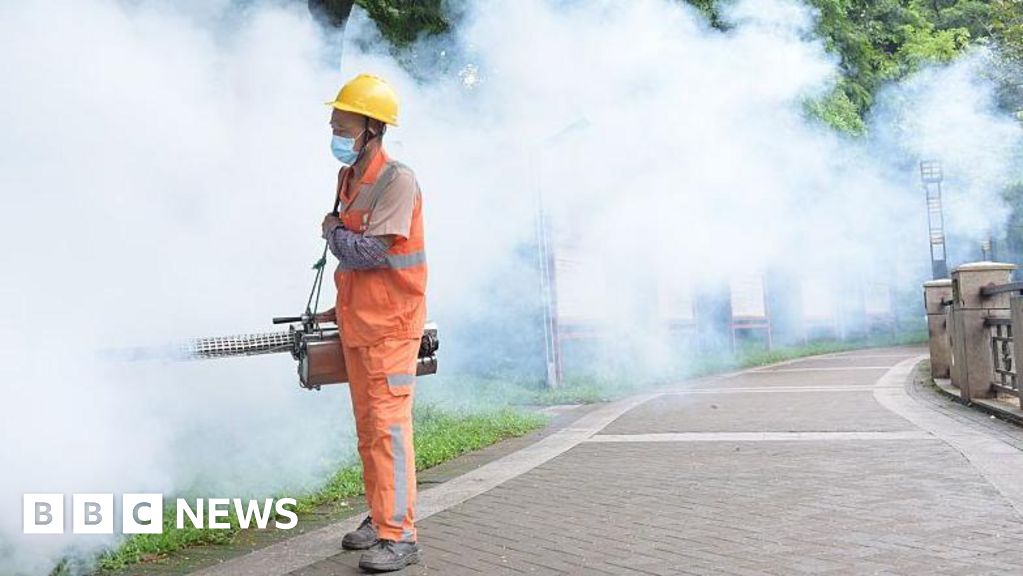Chikungunya Virus In China: Understanding The 7,000-Case Report And Public Health Response

Welcome to your ultimate source for breaking news, trending updates, and in-depth stories from around the world. Whether it's politics, technology, entertainment, sports, or lifestyle, we bring you real-time updates that keep you informed and ahead of the curve.
Our team works tirelessly to ensure you never miss a moment. From the latest developments in global events to the most talked-about topics on social media, our news platform is designed to deliver accurate and timely information, all in one place.
Stay in the know and join thousands of readers who trust us for reliable, up-to-date content. Explore our expertly curated articles and dive deeper into the stories that matter to you. Visit Best Website now and be part of the conversation. Don't miss out on the headlines that shape our world!
Table of Contents
Chikungunya Virus in China: Understanding the 7,000-Case Report and Public Health Response
The recent report of over 7,000 Chikungunya virus cases in China has sent ripples of concern through the global health community. While Chikungunya is not new, its emergence in such significant numbers within China warrants a closer look at the situation, the public health response, and what it means for the future. This article will delve into the details surrounding this outbreak, exploring the virus, its transmission, and the measures being taken to contain its spread.
What is Chikungunya Virus?
Chikungunya virus (CHIKV) is an alphavirus transmitted primarily by infected Aedes mosquitoes, the same genus responsible for spreading Zika and dengue fever. The name "chikungunya" comes from the Makonde language of Tanzania and means "that which bends up," referring to the stooped posture often adopted by those suffering from the intense joint pain characteristic of the infection. While generally not fatal, CHIKV can cause debilitating symptoms that significantly impact quality of life.
Symptoms and Severity:
Symptoms typically appear within a week of being bitten by an infected mosquito and include:
- High fever: Often exceeding 102°F (39°C)
- Severe joint pain: This is a hallmark symptom, often affecting the hands, wrists, ankles, and feet.
- Muscle pain: Widespread aches and pains are common.
- Headache: Often intense and persistent.
- Nausea and vomiting: Gastrointestinal distress can occur.
- Rash: A maculopapular rash may appear.
While most individuals recover within a week or two, some experience chronic joint pain (arthralgia) that can persist for months or even years. Older individuals and those with pre-existing health conditions are at higher risk of severe complications.
The 7,000-Case Report in China: A Closer Look
The reported 7,000 cases represent a significant outbreak, though the exact figures and geographical spread require further clarification from official sources. Understanding the precise locations affected and the demographics of those infected is crucial for effective containment strategies. This information will allow public health officials to pinpoint high-risk areas and target preventative measures accordingly.
Public Health Response and Prevention:
China's public health system has implemented several crucial measures to address this outbreak, including:
- Surveillance and Monitoring: Enhanced surveillance programs are tracking the virus's spread and identifying new cases quickly.
- Vector Control: Intensified efforts to control mosquito populations are underway, focusing on eliminating breeding grounds and using insecticides.
- Public Awareness Campaigns: Educating the public about the virus, its transmission, and preventative measures is vital. This includes promoting the use of mosquito repellents, wearing protective clothing, and eliminating standing water.
- Treatment and Support: Providing access to appropriate medical care for those infected is paramount. While there's no specific antiviral treatment, supportive care focuses on alleviating symptoms.
Looking Ahead: Global Implications
The Chikungunya outbreak in China highlights the global nature of infectious disease threats. Increased international travel and climate change contribute to the spread of mosquito-borne illnesses. International collaboration and robust public health infrastructure are essential for effectively managing and preventing future outbreaks.
Call to Action:
Stay informed about the latest updates on the Chikungunya virus outbreak in China and other regions. Follow guidelines issued by your local health authorities and take proactive measures to protect yourself and your family from mosquito bites. Learn more about the . Understanding the risks and taking preventative steps is crucial in mitigating the impact of this and other emerging infectious diseases.

Thank you for visiting our website, your trusted source for the latest updates and in-depth coverage on Chikungunya Virus In China: Understanding The 7,000-Case Report And Public Health Response. We're committed to keeping you informed with timely and accurate information to meet your curiosity and needs.
If you have any questions, suggestions, or feedback, we'd love to hear from you. Your insights are valuable to us and help us improve to serve you better. Feel free to reach out through our contact page.
Don't forget to bookmark our website and check back regularly for the latest headlines and trending topics. See you next time, and thank you for being part of our growing community!
Featured Posts
-
 Rangers De Grom Shatters Record Fastest Pitcher To 1 800 Career Strikeouts
Aug 06, 2025
Rangers De Grom Shatters Record Fastest Pitcher To 1 800 Career Strikeouts
Aug 06, 2025 -
 Analyzing The Atlanta Falcons After Six Training Camp Sessions
Aug 06, 2025
Analyzing The Atlanta Falcons After Six Training Camp Sessions
Aug 06, 2025 -
 Mariah Carey And Jeff Goldblum Why They Love Jet2 Holidays
Aug 06, 2025
Mariah Carey And Jeff Goldblum Why They Love Jet2 Holidays
Aug 06, 2025 -
 Putin Defiant As Trumps Deadline Approaches
Aug 06, 2025
Putin Defiant As Trumps Deadline Approaches
Aug 06, 2025 -
 Espn Khabibs Concerns For Mc Gregors Well Being And Future
Aug 06, 2025
Espn Khabibs Concerns For Mc Gregors Well Being And Future
Aug 06, 2025
Latest Posts
-
 Post Race Shoving Incident Noah Lyles And Kenny Bednarek At Us Nationals
Aug 06, 2025
Post Race Shoving Incident Noah Lyles And Kenny Bednarek At Us Nationals
Aug 06, 2025 -
 Mariah Carey And Jeff Goldblums Favorite Holiday A Jet2 Escape
Aug 06, 2025
Mariah Carey And Jeff Goldblums Favorite Holiday A Jet2 Escape
Aug 06, 2025 -
 Zach Sielers 67 75 Million Dolphins Extension A Detailed Breakdown
Aug 06, 2025
Zach Sielers 67 75 Million Dolphins Extension A Detailed Breakdown
Aug 06, 2025 -
 Protecting Your Lungs During Wildfire Season A Practical Guide
Aug 06, 2025
Protecting Your Lungs During Wildfire Season A Practical Guide
Aug 06, 2025 -
 Terry Mc Laurins Future Uncertain Trade Or Extension For Commanders Star Receiver
Aug 06, 2025
Terry Mc Laurins Future Uncertain Trade Or Extension For Commanders Star Receiver
Aug 06, 2025
